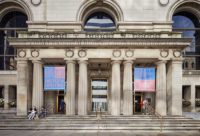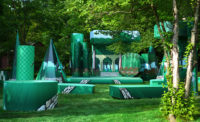The Chicago Cultural Center is the epicenter of the Biennial.
From ArchDaily to Treehugger, a virtual wonderland of websites devoted to architecture, design, and urbanism are piling gigabytes of information atop that generated by publications like architectural record, which also command a significant online presence. Much good has come from this World Wide Web–based cornucopia, even if its abundance does feel overwhelming. Contemporary architecture is vibrant. Globalization has, paradoxically, engendered an unprecedented sensitivity to locality and place, a widespread commitment to buttressing the distinctiveness of societies and cultures, and a salutary blurring of the boundaries among architecture, urbanism, and landscape design.
Much has been gained. But the dispersion and immensity of this polyphonic virtual arena has vanquished the large-scale, synthetic essays that once framed a common discourse on architecture and urbanism. Critical visions are an endangered species. That matters because only they galvanize the kind of debate that challenges practitioners to sharpen or push their ideas, even to change their minds.
One forum that might fill this void is the architecture exposition, where shape-shifting global practitioners congregate. Such events, if properly curated, can nudge architects into reflecting their own ideas through the prism of their colleagues’ visions and accomplishments. Few recent expositions (including those in Venice) have made good on that potential. This makes the inaugural edition of the Chicago Architecture Biennial (CAB), which runs until January 2016, that much more exciting.
Kudos to curators Sarah Herda and Joseph Grima for orchestrating the most focused, substantive exhibition on contemporary architecture in years, perhaps a generation. From nearly 500 submissions, they culled 120 firms, many run by designers of the under-50 generation. Most exhibits are staged in Chicago’s Cultural Center, the city’s original public library, itself an extraordinary Beaux Arts monument, completed in 1883.
Grima and Herda insist that they adopted a big-tent approach that pushes no aesthetic or critical agenda. Luckily for us, that’s not so: Chicago’s biennial is anything but a neutral survey. Even its title, The State of the Art of Architecture, smuggles in a curatorial polemic via subtle provocation. In insisting that architecture is an art, the curators deliberately invoke a formalism that was last overtly championed by American postmodernists in the 1970s, from Peter Eisenman to Michael Graves to Stanley Tigerman, although it continues to be practiced today by architects like Frank Gehry and Zaha Hadid. Herda and Grima purport to continue this tradition by framing architecture as above all an aesthetic practice. Traditionally, that would entail relegating social agendas to the realm of building rather than the form-dominated “art” of architecture.
Not here. Dozens of works exhibited at the Biennial would not, by any conventional standard, be considered art. Certainly not URBZ’s tiny “homegrown” brick residence, though it is dramatically more healthful than its immediate neighbors in the slums of Mumbai, or Yasmeen Lari’s elevated, lime-and-bamboo yurt-like structures for flood-prone villages in Pakistan. These and many other projects exhibited rely on traditional materials, employ local construction practices, and do so in often conventional ways. Innovation lies in how practitioners reinterpret existing typologies to optimize space and light, abide by the dictates of sustainability, and create ordered oases amidst destitute surroundings. Rural Urban Framework’s Andong Village Hospital and Jindai Housing, for example, which earned the Hong Kong firm this year’s Curry Stone Design Prize (page 36), are notable as much for the humanitarian issues they address—the millions of Chinese citizens who stay behind in the country’s vast, impoverished countryside – as for the formal excellence of their designs.
Many of the projects here bespeak a definition of architecture so elastic that we cannot but wonder what the curators are up to. RUA Arquitetos’ large wooden model reveals the Maré favela in Rio de Janiero not as the undifferentiated mass of shanties it superficially resembles but, instead, a self-organizing constellation of 16 distinct neighborhoods that sometimes abut and sometimes bleed into one another. RUA’s contribution? Identifying each community, which they propose marking with some minimally iconic structure, like the open steel-frame Observation Tower that they present for one neighborhood. Another exquisitely creative project, by otherothers, a firm from Sydney, dismantles buildings rather than constructing them: their Offset House remediates the anodyne wastefulness and social isolation of Australia’s suburbs by stripping parts of developer-built houses down to their balloon frames and repurposing the latticed areas into light wells and semi-enclosed terraces and patios. The land between these slenderized houses would be common playgrounds and gardens. Otherothers’s scheme would bring moments of urbanity to the deserts of suburbia by blurring the transition between the public realm of the street and private realm of home, generating the in-between spaces that urbanist Jan Gehl has demonstrated foster communal life.
The curators present a powerful, if implicit, case that, in contemporary architecture, these are the trends that merit our attention. Put another way, as Sou Fujimoto declares in his poetic but hardly profound exhibit of ordinary objects reimagined as buildings, Architecture is everywhere. Design matters, to be sure, but formalism and iconicity are out. Design can be art while addressing the world’s travails.
Today, climate change necessitates sustainable buildings and practices. Ever-expanding poverty and social anomie demand that our public realms be invigorated, that housing be affordable, and that every community be anchored with inspiring schools and flourishing cultural and social institutions. In developed countries beleaguered by commercial blight, we should design with nature and forge art from the detritus of everyday life. Kéré Architecture’s A Place for Gathering is the most prominently featured installation to advance these interlocking agendas. Locally sourced wooden logs form crude amphitheater-like seating where people can commune in groups, read by themselves, people-watch, rest.
Two of the best-represented, and overlapping themes in the Biennial concern affordable housing, on the one hand, and innovating with the tropes and materials of mass production on the other. More speculative projects include the Light House for Bangkok, in which the Thai firm All(zone) envisions ethereally translucent shelters for civilized squatting. MOS’s Corridor House, one of CAB’s four full-scale mock-ups, quietly advances an incisive critique of the American building industry by demonstrating a McMansion’s wastefulness: a light-filled, small but serviceable home occupies only the area that a typical developer-built home devotes to transitional spaces.
Star billing goes to two more low-cost housing prototypes. From interviews with potential residents, Tatiana Bilbao of Mexico City learned that slum dwellers feel stigmatized by the unfinished state of their poured-in-place concrete residences; she concluded that any Mexican affordable home should above all look finished. A simple concrete-block core anchors her “sustainable” house, where wooden pallets and plywood sheets are arranged into a tidy pitched-roof dwelling that looks at once complete yet can be inexpensively reconfigured. Vo Trong Nghia’s full-scale prototype for residents of Vietnam’s impoverished Mekong Delta focuses on transportability and ease of construction. The frame of his spacious one-room S House is comprised of prefabricated galvanized-steel beams that are dimensioned to be light enough for one person to carry and small enough to be shipped on an ordinary truck. A dry-joint system of construction ensures that the entire frame of a small home can be erected by mainly unskilled labor in just hours. Walls, fabricated from whatever material is least expensive locally, affix to this durable frame; at the CAB, the wall panels featured were of dried reeds.
In first-world settings, affordable housing seems less urgent than figuring out how to employ ordinary construction methods and materials without straitjacketing a design. Both Besler & Sons + ATLV and SO-IL creatively feature off-the-shelf metal studs: pavilions by the former replace the usual sloppy joinery of studs to sheetrock with careful, clean details; an astonishingly affecting installation by the latter ennobles an ordinary, ADA-compliant ramp by configuring metal studs as a soaring, quasi-gothic arcade.
Even the CAB’s high-art projects touch upon the curators’ core themes, especially climate change and the public realm. Herda and Grima feature the work of practitioners who are captivated by nature and the dynamics of organic growth. Very likely, this generational pivot toward biomorphism is owing to the twin specters of environmental degradation and climate change. Kindred explorations drive the MIT Media Lab’s Self-Assembly project and Thomás Saraceno’s installation. Saraceno, an artist from Berlin, contributes the CAB’s most theatrical piece: in a blackened room, pedestals present spotlit, glass-encased spiders, spinning their architecture of webs and cocoons.
The exclusion of starchitects and many other kinds of talented practitioners is the least of the CAB’s impressively polemical commission-by-omission. This exhibition is a piercing clarion call: Look at all that architecture can do! By presenting the work of a generation driven to make design a socially relevant practice, the CAB presents a welcome vision of a society in which people, no matter how poor, reside in life-affirming, place-specific homes, and those homes congregate into sustainable communities. Beauty cannot be a commodity just for people who already have bought everything else they need. It’s an art, and it brings order and meaning to a chaotic, often tragic world.









